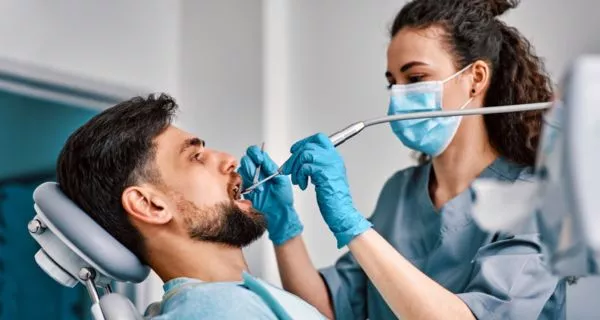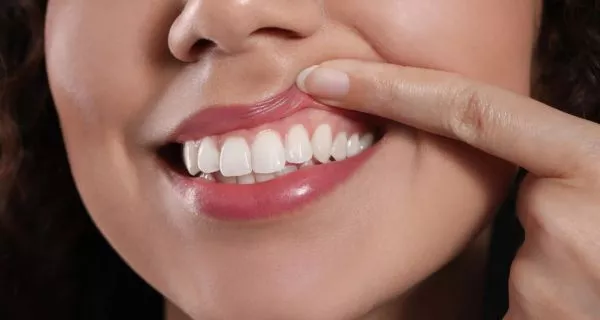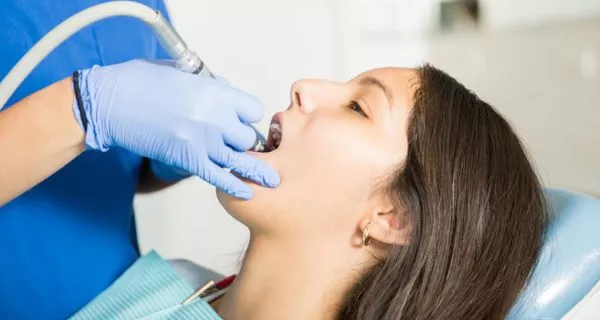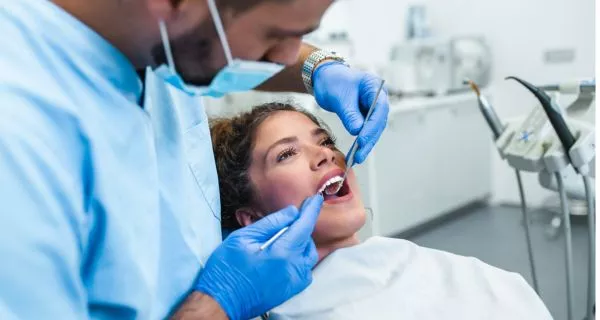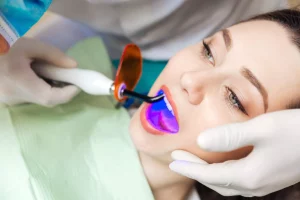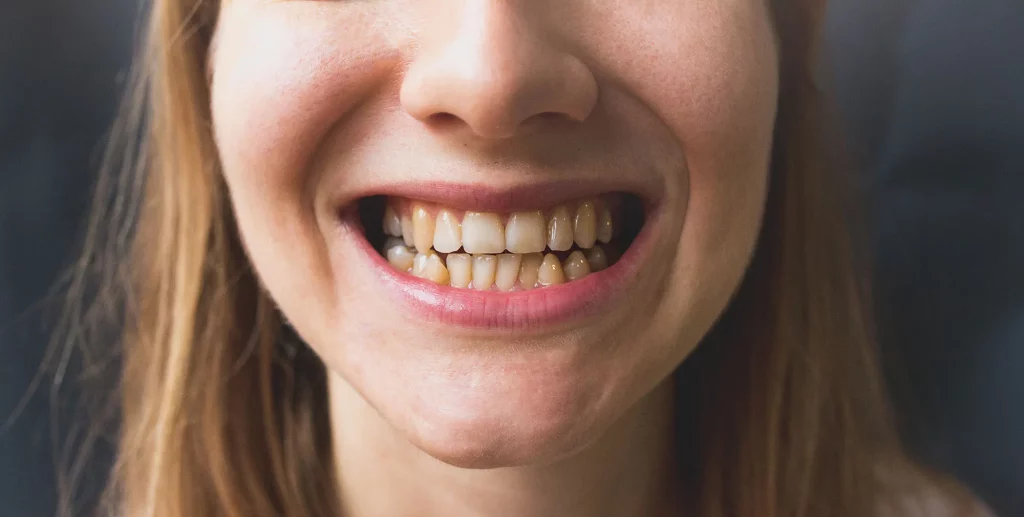There are different types of dental cleaning, depending on your gum health and plaque buildup. These include routine cleaning (prophylaxis), deep cleaning (scaling and root planing), dental debridement, periodontal maintenance, and periodontal surgery. Each type helps remove plaque, tartar, and bacteria to maintain the health of and gums.
Do you love that clean and fresh feeling after a dental visit? It feels amazing! But not every cleaning is the same. Some are simple, while others go deeper to keep your gums healthy. Each one helps protect your smile differently.
Let’s see the main types of dental cleaning and when you might need them.
Table of Contents
ToggleWhat is a dental cleaning?
A dental cleaning, also called prophylaxis, is a simple and professional treatment done by a dentist or dental hygienist.
It removes plaque, tartar (the hard buildup on teeth), and stains that brushing and flossing at home cannot take away.
At Channel Islands Family Dental Office, we recommend getting a cleaning every six months. This helps your teeth stay strong, your gums stay pink and firm, and your breath stay fresh.
When do you need a dental cleaning?
You should have a dental cleaning at least twice a year, even if your teeth look clean. Plaque and tartar can build up slowly and cause gum problems without pain at first.
However, if you have doubts, check out your own gums; they can talk by themselves:
- Healthy gums are pink, firm, and don’t bleed when you brush or floss.
- If your gums look red, swollen, or bleed easily, it can be a sign of gum disease. In this case, you may need a deeper cleaning to remove bacteria under the gums and stop the infection.
Regular checkups help your dentist find these problems early and keep your smile healthy.
What are the benefits of regular dental cleanings?
Dental cleanings are preventive treatments that help keep your teeth and gums healthy for a long time.
When the dentist removes plaque and tartar, it lowers the risk of cavities, gum problems, and tooth loss. Cleanings also help your general health because mouth bacteria can affect the rest of your body.
Here are the main benefits of keeping this healthy habit:
Prevent gum disease and cavities
When plaque stays on your teeth, it becomes tartar. Tartar can irritate your gums and cause gingivitis. If ot treated, it can turn into periodontitis, a more serious gum disease. Professional cleanings remove plaque and tartar before they cause damage. This keeps your gums firm, pink, and healthy.
Keep your breath fresh
Bad breath often comes from bacteria and food stuck between your teeth or under the gums. A complete dental cleaning removes these bacteria and food bits, leaving your mouth clean and your breath fresh.
Improve the look of your smile
During a cleaning, the dentist removes surface stains from coffee, tea, or tobacco. This makes your teeth look whiter, brighter, and healthier without the need for other cosmetic treatments.
Strengthen gums and tooth enamel
Removing tartar and applying fluoride helps make your tooth enamel stronger and your gums more resistant to bleeding or inflammation. This gives your teeth a stronger base and helps prevent bone loss.
Avoid expensive treatments later
When plaque and tartar are removed early, small problems don’t become big ones. Regular cleanings help you avoid deep cavities, infections, or tooth loss, saving money and keeping your natural teeth longer.
Support your overall health
A clean and healthy mouth helps protect your whole body. Studies show that good oral health can reduce the risk of heart, breathing, and metabolic diseases.
As you see, dental cleanings are not only for beauty, they’re an investment in your health and well-being.
What are the types of dental cleaning?
There are different types of dental cleanings, and not every patient needs the same. The dentist chooses the right one based on how healthy your gums are and how much tartar you have.
Let’s look at each type and what makes it different.
1. What is a routine cleaning (prophylaxis)?
This is the most common type of cleaning. It is for people with healthy gums or mild gingivitis.
What it includes:
- removing plaque and tartar above the gum line
- polishing teeth to remove small stains
- applying fluoride for extra protection.
Routine cleanings are usually done every six months. They help keep your teeth clean and prevent gum disease.
2. What is a deep cleaning (scaling and root planing)?
This cleaning is for people with signs of gum disease. It cleans both above and below the gum line, removing bacteria and helping the gums heal.
It includes:
- Cleaning the pockets between the teeth and gums.
- Root planing: smoothing the tooth roots so the gums can reattach.
- Local anesthesia may be used for comfort.
It stops infection, reduces swelling, and prevents further bone loss. Depending on the severity, it may require more than one visit.
3. What is a dental debridement?
This type of cleaning is used when a person has not visited the dentist for many months or years, and there is heavy tartar buildup.
Steps include:
- using ultrasonic tools to remove thick tartar.
- sometimes, applying anesthesia for comfort.
- After the large deposits are removed, a deep cleaning or routine cleaning is scheduled to complete the treatment.
This cleaning is made to prepare the mouth for other treatments and allow the dentist to see the teeth clearly again.
4. What is periodontal maintenance?
After treating gum disease, maintenance is essential to keep the gums healthy. It is recommended every 3 to 4 months for patients with a history of periodontitis.
Benefits:
- removes plaque and tartar from periodontal pockets
- reduces gum inflammation and infection
- prevents the disease from coming back
It is less aggressive than deep cleaning but more detailed than a routine one. This ongoing care helps protect your gums long term.
5. What is periodontal surgery?
In very severe gum disease, normal cleanings are not enough; for this reason, periodontal surgery may be necessary to reach deep areas below the gums.
The procedure includes:
- gently lifting the gums to access infected zones.
- cleaning tartar and removing damaged tissue.
- allowing gums to heal and reattach to the teeth.
This helps save teeth and stop bone loss. Although more invasive, it is very effective in advanced cases.
What to expect from a professional dental cleaning?
A professional cleaning is safe, simple, and helps remove plaque and tartar that brushing alone can’t reach. Most people feel relaxed during the treatment, and any small sensitivity disappears quickly.
The visit usually starts with a complete check-up. The dentist looks at your teeth and gums for any signs of cavities, bleeding, or gum inflammation.
Then the cleaning begins:
- Scaling: The dentist uses special tools to gently remove plaque and tartar from the teeth and under the gum line.
- Polishing: A soft paste is used to make the teeth smooth and shiny.
- Fluoride: A fluoride gel or foam helps strengthen enamel and protect against decay.
- Advice: At the end, your dentist gives you easy tips to brush and floss better at home.
The entire process usually takes about 45–60 minutes, depending on how much cleaning is needed.
How often should you have a dental cleaning?
The American Dental Association (ADA) mentions that for most people, a cleaning every six months is enough to keep their mouth healthy. This routine removes buildup before it causes cavities or gum problems.
However, some people may need cleanings more often — about every 3–4 months — especially if they:
- have gum disease or sensitive gums
- build up tartar quickly
- have diabetes or other health issues that affect healing
Your dentist will determine the best schedule for your personal case. Regular visits will help prevent future pain, infection, or costly treatments.
How to care for your teeth after a cleaning?
A dental cleaning gives your mouth a fresh start, but keeping it that way depends on your daily care.
To protect the results and avoid new buildup, try these habits:
- Brush your teeth after every meal with fluoride toothpaste.
- Floss once a day to clean between your teeth.
- Use a mouthwash to kill bacteria and keep your breath fresh.
- Avoid smoking and limit coffee, tea, or dark drinks that can stain teeth.
- Eat a balanced diet with fruits, vegetables, and water to support gum health.
And of course, keep visiting your dentist regularly. Preventive care is always easier and cheaper than fixing problems later.
Where can you get a professional dental cleaning?
At Channel Islands Family Dental Office, we offer modern and gentle dental cleanings. Our clinics in Oxnard, Santa Paula, Ventura, Newbury Park, and Port Hueneme provide personalized care for every patient.
We offer:
- routine cleanings for prevention
- deep and periodontal treatments for gum care
- comfortable, modern techniques for better results
Taking care of your smile with professionals prevents future problems and gives you confidence every day.
Why should you visit the dentist regularly?
Dental cleanings are a simple way to protect your smile for life.
Cleanings keep your gums firm, your teeth strong, and your breath fresh. When you remove plaque and bacteria often, you prevent gum disease and feel more confident every day.
Taking care of your mouth is just another way to take care of yourself.
Frequently Asked Questions (FAQ)
Yes, cleanings are safe and even recommended. Healthy gums during pregnancy help prevent infections and keep both mom and baby safe.
You can eat right away unless you’ve had a fluoride treatment, then wait 30 minutes. It’s best to eat soft foods and avoid hot, spicy, or sticky foods for the rest of the day, especially if your gums feel tender.
Voice Search Snippets (Q&A)
References
1. Abedi N. (2019). Meta-analysis of the effectiveness of educational interventions on dental and oral health promotion in Iran. J Edu Health. https://www.jehp.net//text.asp?2019/8/1/29/252340
2. Difoggio, W. (June 19, 2021). How Much Does It Cost to Get Your Teeth Cleaned?. Teeth Talk Gir. https://www.teethtalkgirl.com/dental-health/dental-cleaning-cost
3. Dilling W. (January 8, 2019). Dental Visits Decoded: Are Cleanings Necessary?. Dental health. https://www.deltadentalia.com/a-healthy-life/dental-health/teeth-cleanings-are-necessary/
4. Karve, S. (September 07, 2022). Why is a Regular Dental Cleaning Procedure so Important?. Healthnews. https://healthnews.com/family-health/dental-and-oral-health/why-is-a-regular-dental-cleaning-procedure-so-important/
5. Kotsakis, GA, Lian, Q., Ioannou, AL, Michalowicz, BS, John, MT, & Chu, H. (2018). A network meta-analysis of interproximal oral hygiene methods in the reduction of clinical indices of inflammation. Journal of periodontology, 89(5), 558–570. https://doi.org/10.1002/JPER.17-0368
6. Naseem, S., Fatima, SH, Ghazanfar, H., Haq, S., Khan, NA, Mehmood, M., & Ghazanfar, A. (2017). Oral Hygiene Practices and Teeth Cleaning Techniques Among Medical Students. Cureus, 9(7), e1487. https://doi.org/10.7759/cureus.1487

